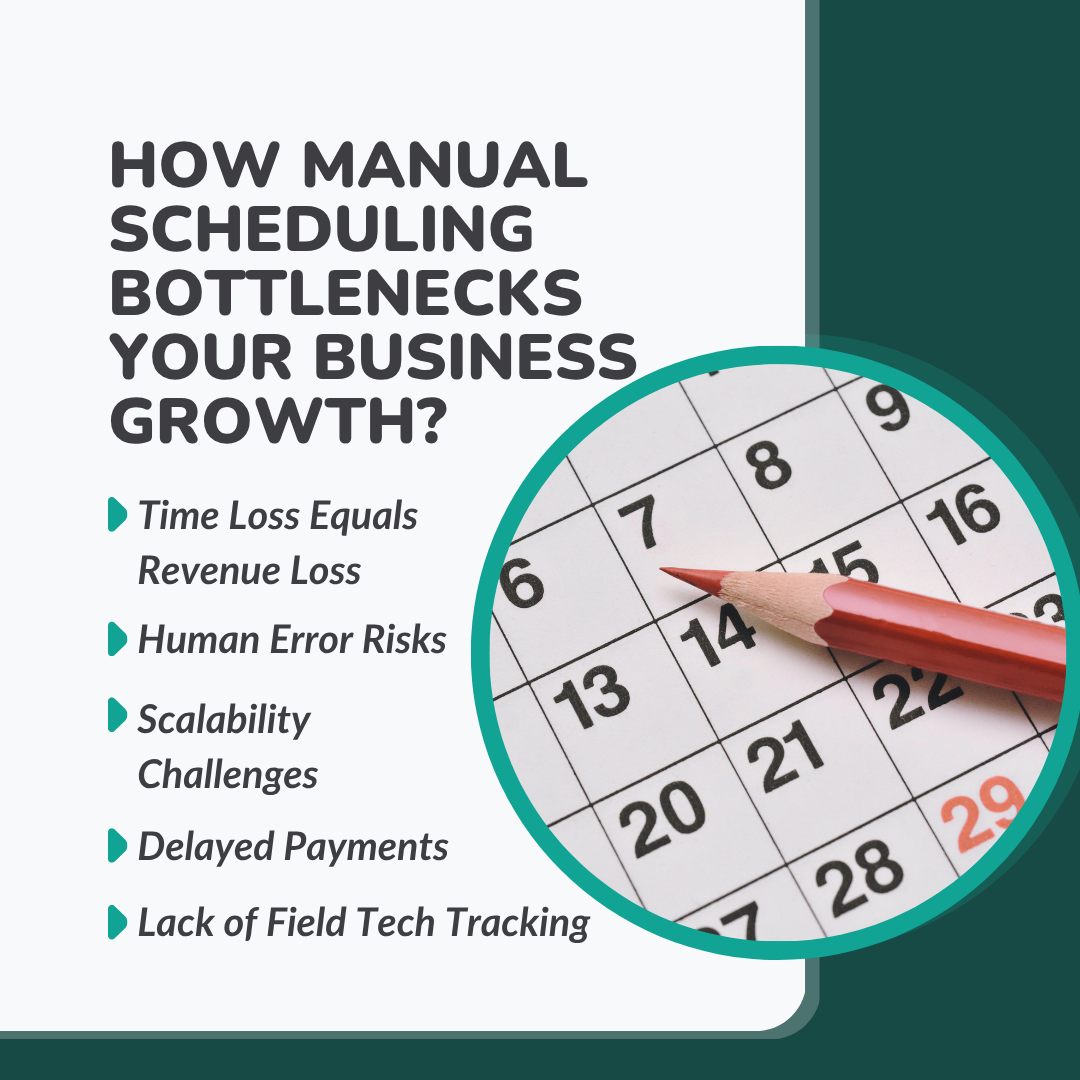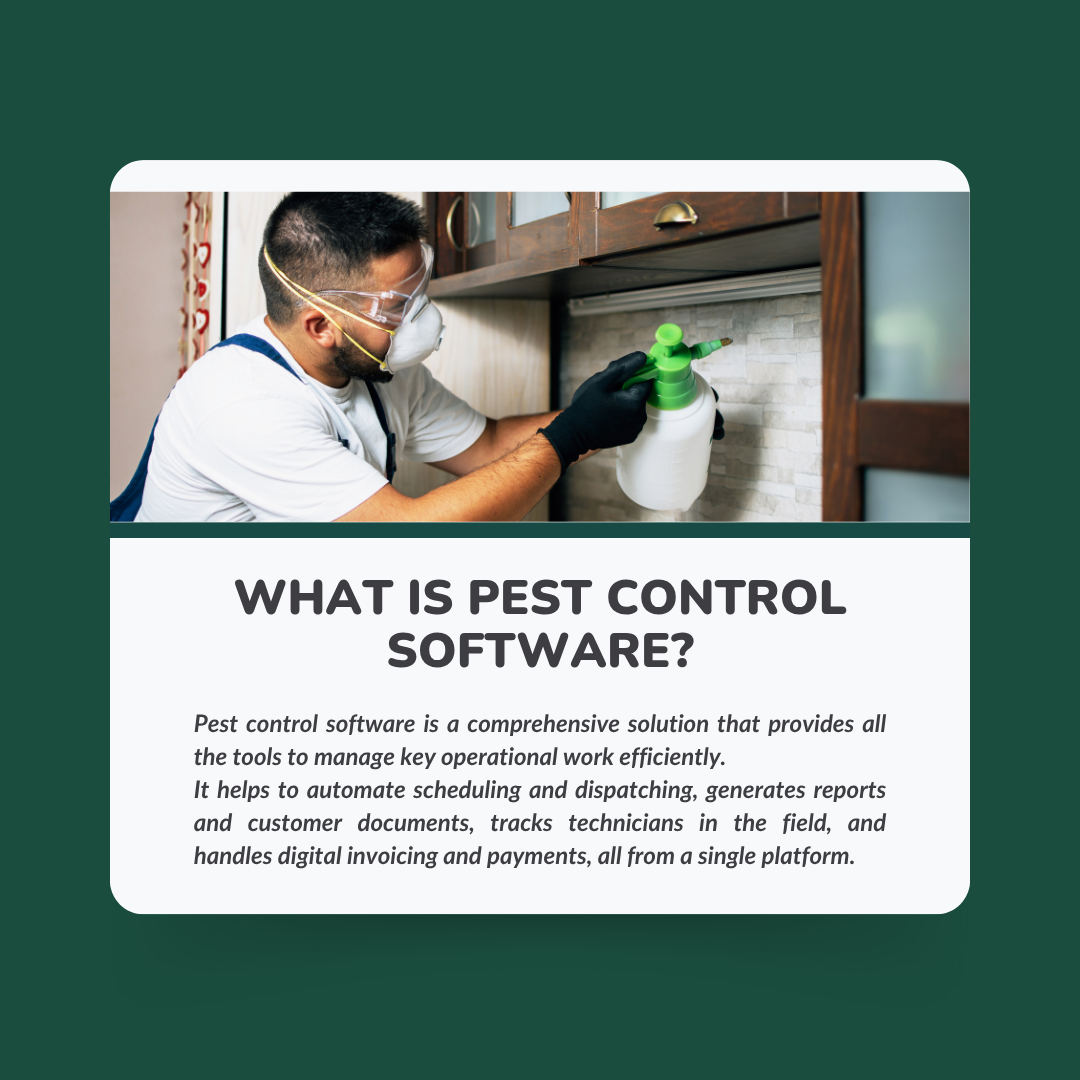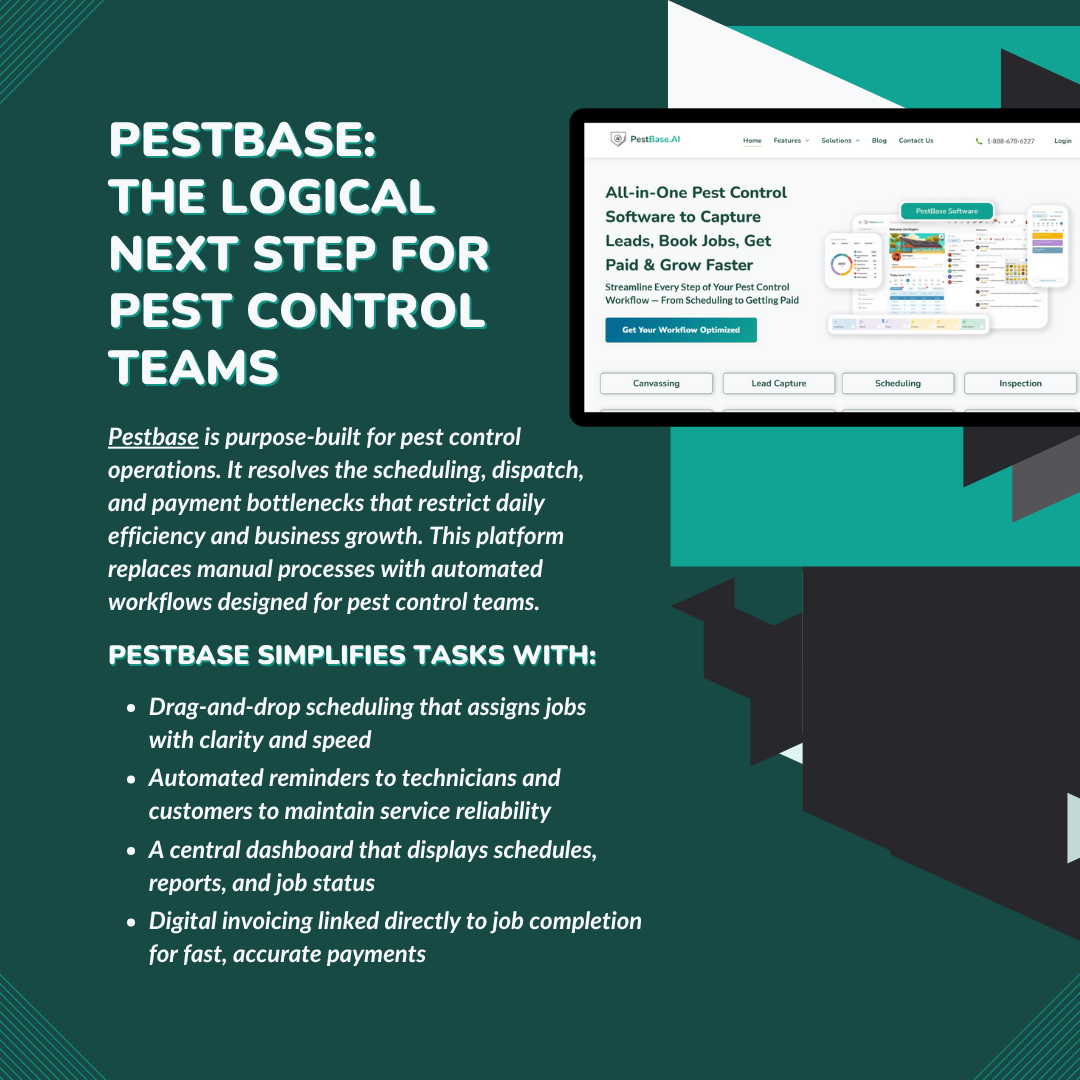August 4, 2025
Audio overview: Listen & Learn
Every morning, spreadsheets and whiteboards are lined up in dispatch rooms in pest control companies. Teams rely on handwritten schedules and calls to keep operations moving.
This approach limits technician productivity, customer satisfaction, and the financial safety regulations of the pest control business.
In pest control, scheduling sits at the heart of its operations. It determines the number of jobs a technician completes in a day, how to attract more customers, and how revenue is generated for the company.
Therefore, this article examines manual scheduling, defines pest control software, and outlines why switching to a purpose-built platform shapes growth in your pest control business.
Pest Control Software vs Manual Scheduling: Key Differences
Manual scheduling takes longer than it would take for a pest control business to prepare reports, process billing, or conduct telephone marketing conversations. Under it, the manager ensures that the right technician is rescheduled to the proper place and time.
Whereas, the software fulfils unique needs, such as real-time tracking, automated scheduling, appointment reminders, and customer relationship management tools, to generate more leads with an efficient workflow in the industry.
Key Takeaway
- Manual planning restricts technician effectiveness, creates mistakes that damage customer trust, and limits your company's growth.
- Pest software eliminates this friction through automated scheduling, live tracking in the field, digital work orders, and invoicing with a button click.
- Teams can work faster and with accuracy.
- Organizations are developing scalable and profitable business models that are tailored to localized markets.
What does Manual Scheduling mean?

Manual scheduling involves planning, assigning, and managing daily tasks without the aid of software. Dispatchers create daily schedules on whiteboards or update paper diaries each morning.
They call technicians to confirm arrival times and handle reroutes when clients reschedule their appointments. Additionally, customer information is stored on paper forms, which are prone to transcription errors or misplaced information.
Manual scheduling depends on human memory and coordination. So, each step carries operational risk when scaling teams and daily job volumes.
The Reality of Manual Scheduling in the Pest Control Business
A. Pain Points for Dispatch Coordinators
- Dispatch coordinators carry the operational load of manual scheduling each day. They invest hours calling technicians to check the status of their jobs.
- Emergencies or delayed jobs demand rapid rescheduling without real-time data. Managing multiple technicians, routes, and last-minute changes while focusing on work can lead to increased daily stress levels.
B. Pain Points for Pest Control Managers
- For pest control managers, manual scheduling has its operational risks. For instance, if managers or techs forget to confirm the appointments or make double bookings, it negatively impacts customers' trust and the company's reputation.
- Paperwork and reports often remain incomplete or go missing, which delays the project's completion. Managers operate without live data on technician productivity, which limits their ability to make decisions that optimise routes or increase daily job completions.
- Manual scheduling creates friction across dispatch and management. It restricts the customer service and constrains business growth potential.
How Manual Scheduling Bottlenecks Your Business Growth?

Let us walk through the complications of using the manual scheduling:
I. Time Loss Equals Revenue Loss
Manual scheduling limits the number of jobs that technicians complete each day. Inefficient dispatching and rescheduling consume valuable service hours that could be converted into revenue-generating visits.
II. Human Error Risks
Manual processes often lead to human errors in confirming job locations, appointment times, and job details. Moreover, a few confirmed orders or billing errors can lead to disputes with customers and disrupt operational services.
III. Scalability Challenges
Manual systems face limitations when businesses expand, such as adding technicians, increasing daily job volumes, or covering new service zones. These service zones encompass residential and office areas, straining existing processes and resources.
IV. Delayed Payments
Paper invoicing lengthens the time between billing cycles. As a result, technicians often submit documents at the end of the day or week, resulting in additional time delays in cash flow and financial planning.
V. Lack of Field Tech Tracking
Manual scheduling is limited by the lack of real-time visibility into technician locations. The inability to confirm a technician's location limits efficiency and increases customer wait time.
What is Pest Control Software?

Pest control software is a comprehensive solution that provides all the tools to manage key operational work efficiently.
It helps to automate scheduling and dispatching, generates reports and customer documents, tracks technicians in the field, and handles digital invoicing and payments, all from a single platform.
The Pest Control Software Market was valued at USD 1.9 billion in 2024, and is anticipated to reach a value of USD 4.5 billion by 2033, at a 10.2% CAGR from 2026 to 2033.
What Modern Pest Control Software Brings to the Table?

The modern pest control software comes with a plethora of benefits. The following are some of the benefits of pest control software and how it transforms your business:
A. Scheduling with technology
Software smartly assigns jobs based on technician availability, location, and requirements. This automation removes double scheduling and maximises daily job completions without manual coordination.
B. Real-Time Field Tech Tracking
Live tracking displays technicians' locations throughout the day. It dispatches coordinators efficiently, reassigns jobs based on proximity, and customers receive timely updates on technician arrival times.
C. Digital Invoicing
Invoices are generated instantly upon job completion. This feature accelerates payment cycles and reduces administrative tasks linked to manual billing.
D. Error Reduction
Centralized information maintains accurate customer records and job details. This precision removes errors that often occur with handwritten notes or disconnected systems.
E. Scalability
Pest software supports business growth. The crew can onboard additional technicians, expand service areas, and introduce new service types — whether residential or commercial — without disrupting the operational flow.
Also Read: Best Pest Control Software for Small Businesses in 2025
Manual Scheduling vs Pest Control Software: At-a-Glance
| Feature | Manual Scheduling | Pest Control Software |
|---|---|---|
| Job Assignment | Paper, whiteboard, or calls | Automated, drag-and-drop interface |
| Field Tech Updates | Phone/text check-ins | Real-time GPS tracking |
| Work Orders | Printed sheets, handwritten notes | Digital, linked to a job in real time |
| Invoicing | Delayed, paper-based | Instant digital invoicing after job completion |
| Error risk | High — missed jobs, wrong info | Low — centralized, validated data |
| Rescheduling | Time-consuming, manual coordination | One-click reassignment |
| Scalability | Breaks under volume | Scales with team and service expansion |
| Customer Communication | Manual calls or follow-ups | Automated reminders and updates |
| Reporting | Spreadsheet-based, limited insights | Live dashboards and performance reports |
| Cash Flow Impact | Delays due to slow invoicing and lost paperwork | Faster payments, cleaner revenue tracking |
How to Choose the Right Pest Control Software for Your Business?
Step 1: Know Your Operational Needs
Analyze daily workflows to understand what the software must support. Consider crew size, number of jobs scheduled each day, and the range of services offered.
This clarity will help you make an informed decision in software selection, aligning it with actual operational demands.
Step 2: Must-Have Features
Evaluate core features that streamline operations:
- Scheduling automation to maximize technician productivity
- Field tech tracking for live operational visibility
- Work order management for seamless job execution
- Customer communication tools for confirmations, reminders, and updates
Step 3: Easy to Use
Select software with an intuitive interface. Dispatch coordinators and technicians adopt tools faster when navigation is logical and straightforward.
Step 4: Integration and Growth
Ensure that the chosen software connects well with other software. Look for solutions designed for growth as your crew grows and might serve more areas.
Step 5: Support and Training
Assess onboarding support and the responsiveness of customer service. Practical training and dedicated support reduce transition time and strengthen software ROI.
Pestbase: The Logical Next Step for Pest Control Teams

Pestbase is purpose-built for pest control operations. It resolves the scheduling, dispatch, and payment bottlenecks that restrict daily efficiency and business growth. This platform replaces manual processes with automated workflows designed for pest control teams.
Key Features for Target Personas:
I.Dispatch Coordinators
Pestbase simplifies daily scheduling tasks with:
- Drag-and-drop scheduling that assigns jobs with clarity and speed
- Live technician tracking for informed dispatch decisions
- Automated reminders to technicians and customers to maintain service reliability
II.Pest Control Managers
Managers gain operational visibility and financial control with:
- A central dashboard that displays schedules, reports, and job status
- Digital invoicing linked directly to job completion for fast, accurate payments
- Insights and reports detailing technician performance, job statuses, and revenue trends
Final Verdict: Why It Matters to Switch Now?
Manual scheduling consumes valuable operational hours. It creates errors in job assignments, customer details, and payments. These inefficiencies restrict daily productivity and limit business growth.
Pest software transforms how teams operate and attract more customers. This is where platforms like Pestbase help you automate scheduling, streamline work and reports, and provide efficient invoicing.
This shift builds a business model that scales efficiently and increases profitability with each technician added and job completed.
Don’t Let Manual Scheduling Limit Tomorrow’s Revenue!
Manual scheduling restricts the ways your marketing team operates each day.
Pestbase provides dispatch coordinators with a drag-and-drop scheduler and real-time access to technician tracking. Managers have immediate access to work, reports, and performance analytics capabilities, all in one dashboard.
So, book your Pestbase demo and streamline your operations.
FAQs
Q.1 What is the most favourable time for pest control?
Pest control should be completed in the morning or the afternoon, depending on your availability.
Q.2 How does pest control software help my business scale?
Pest control software helps grow your business by automating scheduling. Staff will be able to perform more jobs per day via accurate field tech tracking and digital work orders, enabling technicians and services to reach customers in the quickest way possible.
Q.3 How much does it cost for pest control software?
The costs of pest control software vary depending on the price and features. Most pest control software providers can offer tiered pricing to accommodate both small groups and larger organizations.
